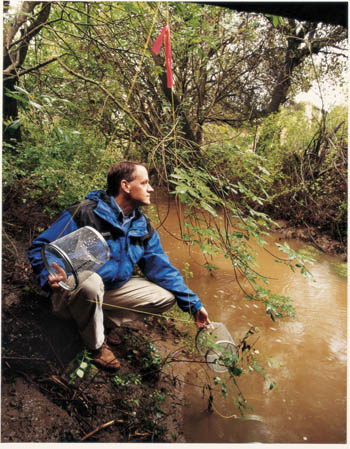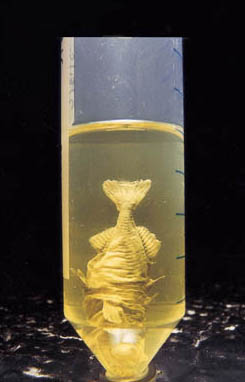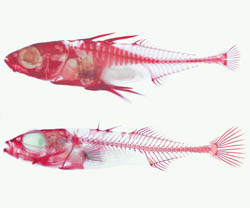Research on sticklebacks blows anti-evolution arguments out of the water
Ethan Hill |
|
 |
|
| David Kingsley sets traps to catch sticklebacks in Matadero Creek — just a few miles from Stanford. He and his colleagues collect the fish from around the world to study how they’ve evolved at different sites. |
By AMY ADAMS
More than 10,000 years ago glaciers covered the land, and a 4-inch, heavily armored fish called the threespine stickleback cruised the ocean waters, gobbling up larvae and other prey. These fish were ubiquitous coastal denizens throughout the Northern Hemisphere.
Then something potentially tragic happened — the ice age ended and glaciers began to recede. Groups of sticklebacks swam up newly formed streams and became stranded in the many freshwater lakes that sprang up in the trail of the ebbing glaciers. The fish, once suited for an ocean environment, had to adapt or die.
Sticklebacks competed for food and mates and struggled to avoid predators and parasites in their new environments. These forces shaped which fish survived and reproduced. In lakes with quick predators, the smallest, sleekest sticklebacks prevailed. In other environments, slower, bottom-dwelling sticklebacks were best able to avoid predators. Still other populations developed bright colors, new ways of feeding or the ability to cope with more or less salt in the water. In all, sticklebacks became so diverse that naturalists originally divided them into 40 different species.
Related story: |
|||||
Some adaptations were particularly remarkable — some fish populations lost entire fins, completely rearranged their jaws, doubled their number of teeth or shed their armored plates. Creationists might say that God gave those sticklebacks the tools they needed to survive. Most biologists say, What a gorgeous example of evolution at work.
David Kingsley, PhD, a Stanford evolutionary biologist, falls solidly on the side of those who think sticklebacks, with their recent evolution and diverse forms, are an ideal way to answer some questions about how evolution proceeds.
Kingsley is curious about how the major differences between animals come about. Did evolutionary changes occur through infinitesimal alterations in thousands of genes, as once predicted, or could relatively few mutations instantly transform an animal into something completely different? Five years ago, Kingsley began genetic investigations of stickleback populations, hoping that the species’ diverse body types and relatively recent evolution would bring some clarity.
Ethan Hill |
|
 |
|
Although his primary goal is to better understand evolution, in the process he’d like to debunk creationists’ claims that evolutionary forces are too wimpy to produce major biological transformations. While many of evolution’s opponents concede that small-scale evolutionary changes take place — such as bacteria evolving resistance to antibiotics — they deny that evolution can give rise to major structural changes.
Kingsley’s scientific mission plays out beyond evolution. “We have to make decisions based on reason, logic and evidence. Opponents of evolution want to create a cloud of confusion around the science in order to give people the impression that the science is uncertain,” he says. This suspicion of science affects how people make decisions about their health, the environment or even politics.
For those who are interested in what science can show, Kingsley has accumulated genetic data to make evolution’s case.
Lend a helping fin
For decades, evolutionary scientists have debated how evolution drives major body overhauls. Their discussions were largely theoretical because observing a phenomenon that unfolds over thousands of years is impossible, and digging for information in animals’ genetic records seemed equally futile. “Genetics is really powerful, but only if you can do the experiment,” says Kingsley, a professor of developmental biology and a Howard Hughes Medical Institute investigator. Until recently, he didn’t see how genetic analysis of evolution in action would be possible.
Mike Shapiro, PhD |
|
 |
|
To understand how, say, whales lost their legs, the ideal investigation would begin by breeding a hippo (the whale’s last land ancestor) and a whale. Those offspring would be uniformly half hippo and half whale. Then breed those hybrids to produce a generation that inherits a varied mixture of hippo and whale genes. A sleuthing geneticist could then compare DNA from all the offspring with hind limbs to the DNA of offspring without. And voilà, the gene or genes controlling leglessness would emerge.
The problem is that hippos and whales can’t reproduce with each other, nor can lizards and birds or any other pair of widely diverging species.
But sticklebacks can. Despite looking dramatically different from one another, sticklebacks from one population can usually breed with others. And in cases where the two populations won’t mate, Kingsley and his colleagues can overcome the reproductive barriers using in vitro fertilization. That key fact is what makes sticklebacks uniquely suited for the type of genetic analysis Kingsley has in mind.
The fish are also conveniently small and simple to raise in the lab, plentiful in the wild and easy to catch. And they tend to have large numbers of offspring, making it possible to generate the thousands of fish needed for genetic analysis. Although researchers are investigating fruit fly species for similar types of experiments, sticklebacks are currently the best system available for studying how dramatic variations arise in different vertebrate species.
Kingsley thinks the stickleback is such a good model for studying how vertebrates evolve that he helped convince the National Institutes of Health to sequence the stickleback genome. At Stanford, Kingsley has assembled a map of the stickleback’s chromosomes showing regions that are variable between populations.
So far, Kingsley has worked out genetic changes that are responsible for two of the biggest differences between stickleback populations — the loss of the hind fins and the loss of body armor. Both of these adaptations happened in many independent groups of sticklebacks.
In a 2004 Nature paper, his group showed that stickleback populations caught by colleagues in Vancouver, Canada, and in Iceland had lost their pelvic fins through a mutation in a gene known as Pitx1. This gene still makes a perfectly normal protein. What’s different is where that protein appears in the developing fish. Although the Pitx1 protein still does its normal job in the head, it is no longer active in the pelvic region of fish that lacked pelvic fins.
“We think this is how evolution has been able to sidestep major problems. The natural mutation only subtracts part of what the gene normally does, preserving the function in other tissues,” Kingsley says.
In a 2005 Science paper the group extended its work to stickleback populations that had lost body armor. As with the missing pelvic fins, each of the 15 populations flown in from colleagues around the globe or collected locally by Kingsley’s lab members had mutations in a single gene. This same gene controls how hair, teeth and sweat glands form in humans. As with Pitx1, the mutation altered where the gene was used in the fish but didn’t change the protein made by that gene.
In both of these examples, Kingsley found that dramatic changes in skeletal structures arose from relatively simple genetic mechanisms. “We’re starting to learn how evolution works on a large scale,” he says. What they are learning is that evolution works one mutation at a time.
What’s more, the same type of mutation in primitive, semi-aquatic hippos could have eliminated or at least reduced the animals’ legs — one step on the long trip to becoming whales. Confirmation for this comes from mice, where animals with a Pitx1 mutation have smaller limbs. According to Kingsley, here’s evidence of the type of genetic alterations that can change entire vertebrate body structures in a single swoop.
Kingsley says his results bring the argument back to the antibiotic-resistant bacteria. Anti-evolution critics accept that antibiotic resistance occurs, but dismiss it as too minor to be considered evolution. In bacteria, single-gene mutations cause an important biochemical change, conferring resistance to antibiotics. In sticklebacks, similar types of single-gene mutations cause major skeletal alterations. It’s the same type of genetic change.
True, he admits his work so far doesn’t explain how animals evolved dramatically different body types. However, he says it’s a first step. “To deal with any complex problem you have to break it down into parts. That’s true here, too. We can start to explain these large changes like the loss of pelvic fins or presence or absence of armor plates. The underlying mechanisms are mutations in particular genes, exactly the same as antibiotic resistance,” Kingsley says.
The transformation of a hippo ancestor into a whale, for example, appears long and complicated, but the individual steps may be as simple as individual mutations in genes such as Pitx1. By breaking a complex evolutionary change into small parts, as Kingsley says, it becomes possible to explain the inexplicable.
Whether his explanation is accepted by evolutionary foes remains to be seen. He admits that no matter how many examples he finds showing the genetic basis of evolution, people who don’t want to believe in evolution will probably continue to raise doubts. He points out that many of the same people he’s trying to win over still cling to the belief that the Earth is 6,000 years old, as some interpretations of the Bible suggest.
“There are so many lines of evidence that the Earth is older than 6,000 years that it should be beyond debate if you are basing your beliefs on science,” he says. “Young-earth creationists are flatly ignoring centuries of accumulated evidence from geology, physics and astrophysics.” But if people aren’t basing their beliefs on science, then no amount of evidence will convince them either that the Earth is several billion years old or that evolution shaped the plants and animals around us.
Despite those concerns, Kingsley plans to continue mining stickleback populations for clues about how evolution proceeds — and perhaps even convince a few diehard skeptics along the way.
Comments? Contact Stanford Medicine at


